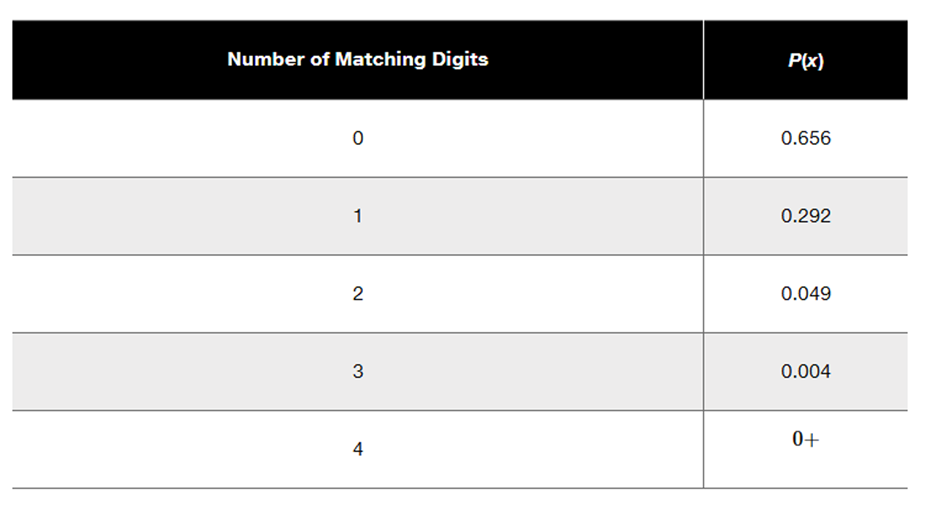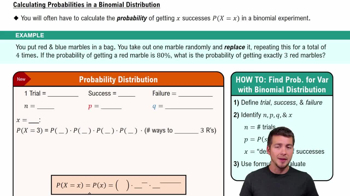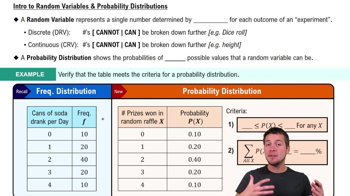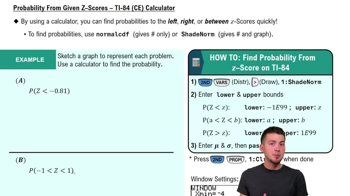Notation For a polygraph (lie detector) used when a subject is presented with a question, let L= the subject lied and let Y = the polygraph indicated that the subject told a lie. Use your own words to translate the notation P (Y|L) into a verbal statement.
Table of contents
- 1. Intro to Stats and Collecting Data1h 14m
- 2. Describing Data with Tables and Graphs1h 55m
- 3. Describing Data Numerically2h 5m
- 4. Probability2h 16m
- 5. Binomial Distribution & Discrete Random Variables3h 6m
- 6. Normal Distribution and Continuous Random Variables2h 11m
- 7. Sampling Distributions & Confidence Intervals: Mean3h 23m
- Sampling Distribution of the Sample Mean and Central Limit Theorem19m
- Distribution of Sample Mean - Excel23m
- Introduction to Confidence Intervals15m
- Confidence Intervals for Population Mean1h 18m
- Determining the Minimum Sample Size Required12m
- Finding Probabilities and T Critical Values - Excel28m
- Confidence Intervals for Population Means - Excel25m
- 8. Sampling Distributions & Confidence Intervals: Proportion1h 25m
- 9. Hypothesis Testing for One Sample3h 29m
- 10. Hypothesis Testing for Two Samples4h 50m
- Two Proportions1h 13m
- Two Proportions Hypothesis Test - Excel28m
- Two Means - Unknown, Unequal Variance1h 3m
- Two Means - Unknown Variances Hypothesis Test - Excel12m
- Two Means - Unknown, Equal Variance15m
- Two Means - Unknown, Equal Variances Hypothesis Test - Excel9m
- Two Means - Known Variance12m
- Two Means - Sigma Known Hypothesis Test - Excel21m
- Two Means - Matched Pairs (Dependent Samples)42m
- Matched Pairs Hypothesis Test - Excel12m
- 11. Correlation1h 6m
- 12. Regression1h 50m
- 13. Chi-Square Tests & Goodness of Fit1h 57m
- 14. ANOVA1h 57m
4. Probability
Basic Concepts of Probability
Problem 5.1.19a
Textbook Question
Lottery. In Exercises 15–20, refer to the accompanying table, which describes probabilities for the California Daily 4 lottery. The player selects four digits with repetition allowed, and the random variable x is the number of digits that match those in the same order that they are drawn (for a “straight” bet).

Using Probabilities for Significant Events
a. Find the probability of getting exactly 3 matches.
 Verified step by step guidance
Verified step by step guidance1
Step 1: Understand the problem. The goal is to find the probability of getting exactly 3 matches in the California Daily 4 lottery. The table provided lists the probabilities for different numbers of matching digits (x).
Step 2: Locate the relevant probability in the table. The table shows the probability P(x) for each number of matching digits. For x = 3 (exactly 3 matches), the corresponding probability is 0.004.
Step 3: Interpret the probability. The value 0.004 represents the likelihood of selecting 3 digits that match the drawn digits in the same order during a 'straight' bet.
Step 4: Verify the context. Ensure that the table and problem description align with the calculation. The table explicitly provides the probability for x = 3, so no further computation is needed.
Step 5: Conclude the process. The probability of getting exactly 3 matches is directly obtained from the table as 0.004. This concludes the solution process.
 Verified video answer for a similar problem:
Verified video answer for a similar problem:This video solution was recommended by our tutors as helpful for the problem above
Video duration:
1mPlay a video:
Was this helpful?
Key Concepts
Here are the essential concepts you must grasp in order to answer the question correctly.
Probability Distribution
A probability distribution describes how the probabilities of a random variable are distributed across its possible values. In this case, the random variable x represents the number of matching digits in the lottery, and the table provides the probabilities for each possible outcome (0 to 4 matches). Understanding this distribution is crucial for calculating the likelihood of specific events, such as getting exactly 3 matches.
Recommended video:
Guided course

Calculating Probabilities in a Binomial Distribution
Random Variable
A random variable is a numerical outcome of a random phenomenon. In the context of the lottery question, the random variable x indicates the number of digits that match the drawn numbers in the same order. Recognizing how random variables function helps in analyzing the probabilities associated with different outcomes in probabilistic scenarios.
Recommended video:
Guided course

Intro to Random Variables & Probability Distributions
Calculating Probabilities
Calculating probabilities involves determining the likelihood of a specific event occurring based on a probability distribution. For this question, to find the probability of getting exactly 3 matches, one would refer to the provided table and identify the corresponding probability value, which is 0.004. This process is fundamental in statistics for making informed predictions about random events.
Recommended video:
Guided course

Probability From Given Z-Scores - TI-84 (CE) Calculator

 5:37m
5:37mWatch next
Master Introduction to Probability with a bite sized video explanation from Patrick
Start learningRelated Videos
Related Practice
Textbook Question
